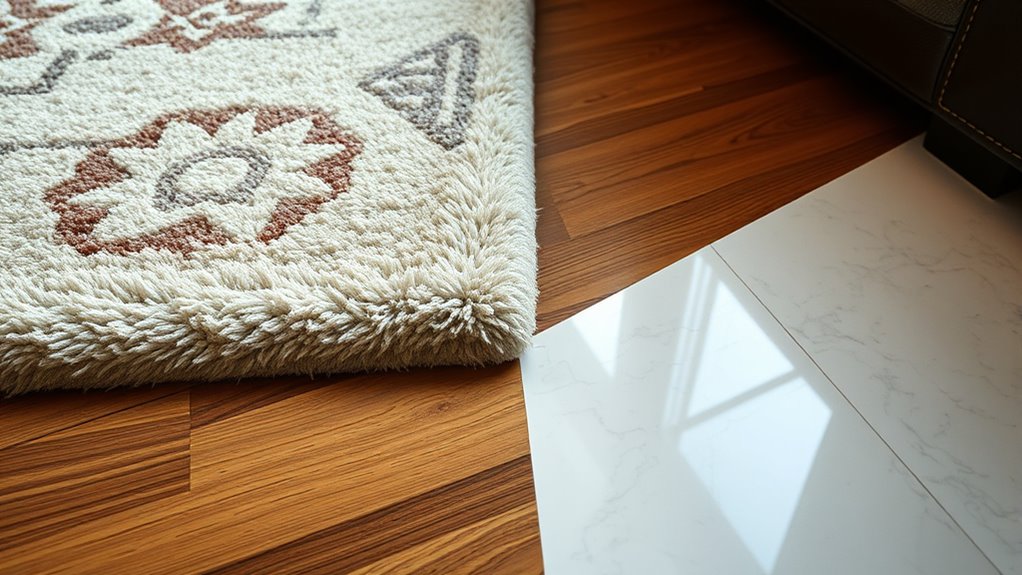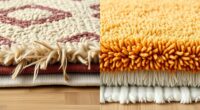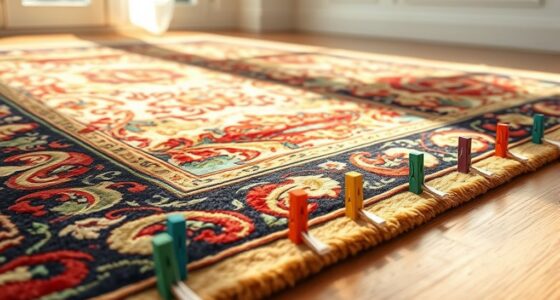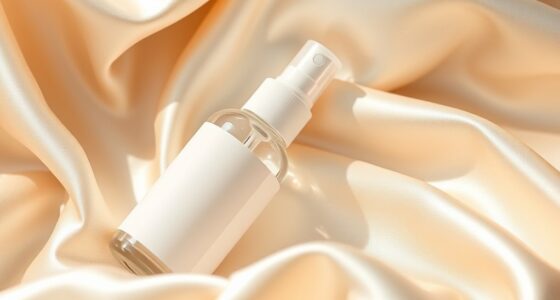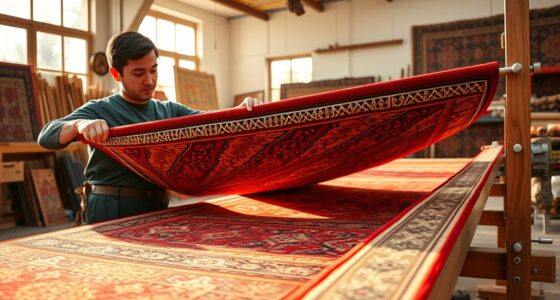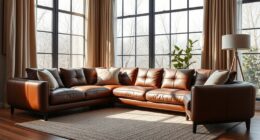Choosing the right rug pad depends on your surface. For hardwood, look for pads with cushioning that protect the finish, prevent scratches, and offer slip resistance. For marble, prioritize moisture-resistant, breathable pads that avoid chemical reactions or staining. Both surfaces benefit from eco-friendly, durable materials that prevent damage. Proper compatibility with your floor’s coating guarantees longevity. Want to know more about selecting the perfect underlay for your floors? Keep exploring these key points.
Key Takeaways
- Choose moisture-resistant, breathable pads to prevent mold and protect both hardwood and marble surfaces.
- Select compatible materials like felt or natural rubber to avoid chemical reactions and surface damage.
- Opt for non-slip backing to ensure safety and stability on both hardwood and marble floors.
- Use pads with proper cushioning to distribute weight evenly and prevent indentation or surface deterioration.
- Avoid synthetic or cheap materials that may cause staining, reactions, or wear over time on delicate surfaces.
Understanding the Differences Between Hardwood and Marble Floors
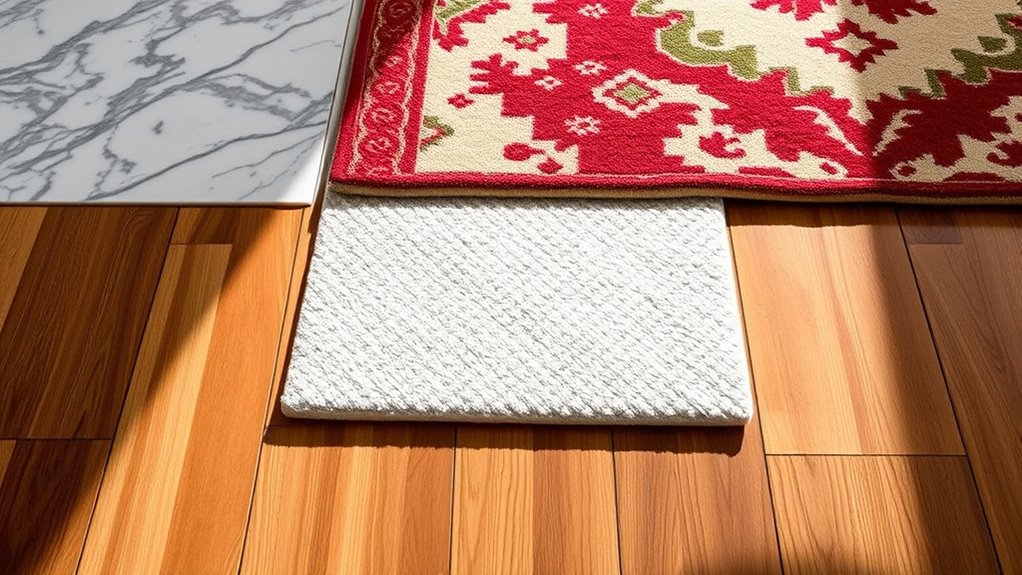
When choosing between hardwood and marble floors, understanding their fundamental differences can help you make an informed decision. Hardwood flooring offers warmth and a natural aesthetic enhancement, creating a cozy, inviting atmosphere. Its installation process is generally straightforward, allowing for easier repairs or refinishing over time. Marble, on the other hand, provides a luxurious, elegant look with a sleek, reflective surface that instantly elevates any space. Its flooring installation requires more precision and care, often involving specialized techniques. Marble’s durability differs from hardwood, as it’s more susceptible to scratching and staining. Knowing these distinctions helps you select the right material for your needs, ensuring your choice aligns with your aesthetic goals and maintenance preferences. Additionally, understanding environmental considerations such as sustainability and impact on ecosystems can inform more eco-conscious decisions when selecting flooring materials.
The Importance of Proper Cushioning for Your Flooring Type
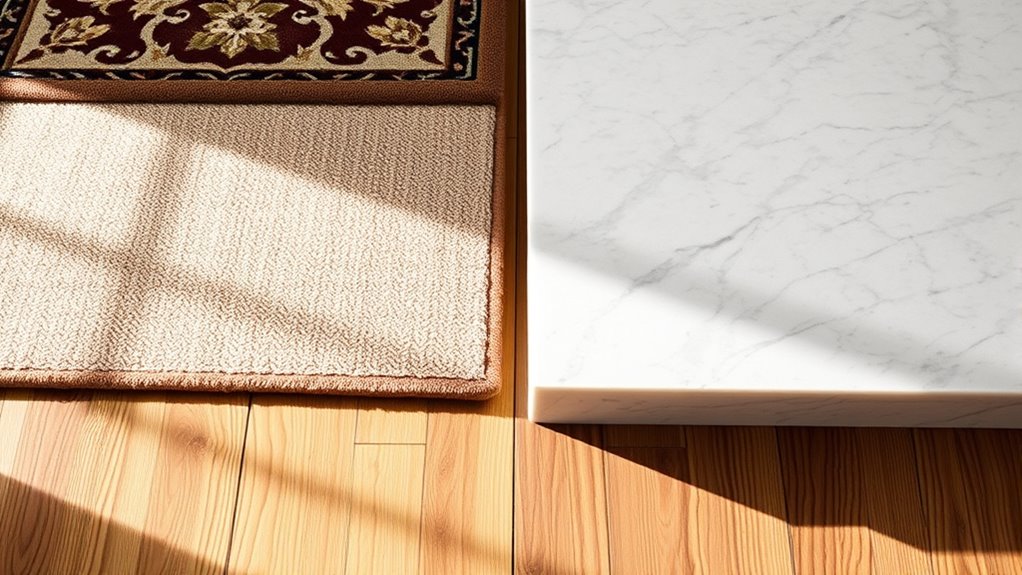
Choosing the right flooring material is only part of creating a durable and comfortable space; proper cushioning plays an essential role in enhancing both function and longevity. Good cushioning impact absorbs shocks, reducing stress on your floors and preventing damage over time. It also provides a softer feel underfoot, boosting comfort and safety. Additionally, the right rug pad offers aesthetic enhancement, making your flooring look more polished and inviting. Consider this table to understand how cushioning benefits different surfaces:
| Flooring Type | Cushioning Impact | Aesthetic Enhancement |
|---|---|---|
| Hardwood | Protects finish, reduces dents | Creates a seamless look |
| Marble | Prevents cracking, absorbs impact | Enhances visual appeal |
| Both | Extends lifespan, improves comfort | Adds refined appearance |
Material Options for Rug Pads and Their Suitability
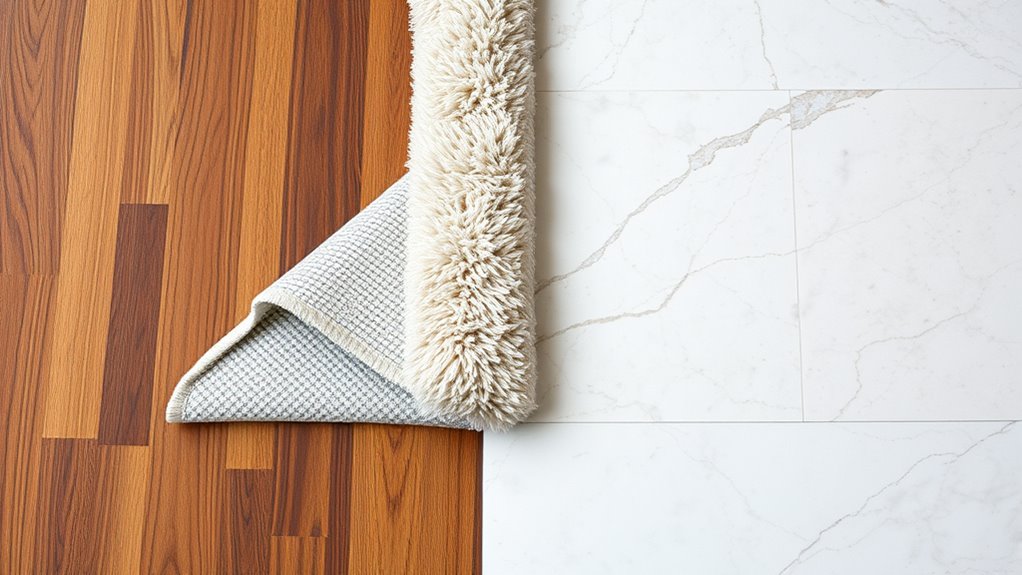
Selecting the right material for your rug pad is crucial to guarantee compatibility with your flooring and maximize cushioning benefits. Durability matters because your rug pad needs to withstand foot traffic without breaking down or losing its supportive qualities. Common options like felt, rubber, or combined materials offer different levels of strength and longevity. If you’re eco-conscious, look for eco-friendly options such as natural rubber or recycled felt, which provide longevity without harming the environment. These materials resist wear and tear, ensuring your rug stays in place and your floors remain protected. Additionally, choosing a material with moisture resistance can help prevent mold and mildew buildup over time. Incorporating moisture-resistant materials is especially beneficial for areas prone to spills or high humidity, helping to extend the lifespan of your rug pad. Selecting a material with antimicrobial properties can further inhibit the growth of mold, bacteria, and fungi, promoting a healthier environment. Avoid cheap or synthetic materials that may degrade quickly or cause damage over time. Choosing a sturdy, eco-friendly material ensures your rug pad performs well and aligns with your sustainability goals. To further enhance durability, consider materials that are also easy to clean, making maintenance simpler and your rug pad last longer.
Non-Slip Features and Safety Considerations
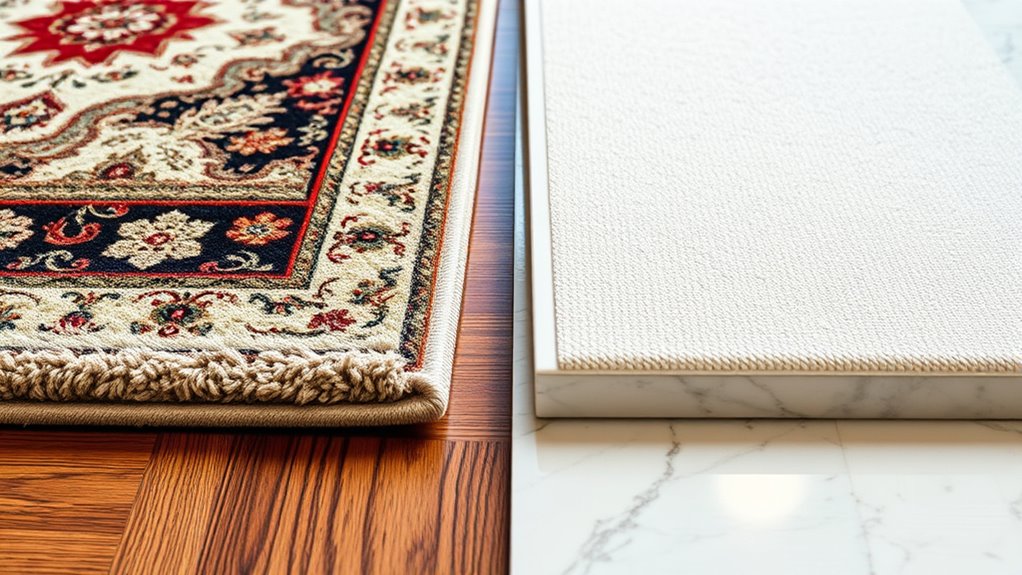
A rug pad’s non-slip features play a crucial role in safety and stability. By enhancing slip resistance, you reduce the risk of accidental slips and falls, especially on smooth surfaces like hardwood and marble. Look for pads with textured or rubberized backing that grip the floor securely. These safety enhancements are vital in high-traffic areas or homes with children and elderly residents. A good non-slip rug pad prevents shifting or bunching, which can cause tripping hazards. Always ensure the pad’s material is suitable for your floor type to avoid damage while maximizing grip. Additionally, floor protection is an important aspect to consider, as certain materials can be damaged by incompatible rug pads. Incorporating digital literacy programs can also promote safer and more playful communication among seniors, which complements the safety benefits of a well-chosen rug pad. Investing in a rug pad with reliable slip resistance not only protects your flooring but also creates a safer environment for everyone in your home. Furthermore, selecting a pad made from hydrocolloid material can help absorb moisture and reduce the risk of mold or damage in humid environments. Using a rug pad with anti-microbial properties can also help prevent mold and bacteria growth, maintaining a healthier living space.
Protecting Your Surface From Damage and Scratches

While a rug pad provides stability, it also plays an essential role in protecting your flooring from damage and scratches. Without a proper pad, dirt accumulation can act like tiny abrasives, gradually wearing down hardwood or marble surfaces. A quality rug pad creates a barrier that prevents dirt from grinding into the surface, reducing potential scratches. Additionally, certain pads help trap allergens and dust, preventing them from settling directly on your floor and minimizing their abrasive impact. This protection keeps your surface looking its best and extends its lifespan. Choosing the right rug pad ensures that your flooring remains free from scratches caused by shifting, friction, or trapped debris, offering both safety and longevity for your investment. Moreover, selecting a pad with appropriate material compatibility ensures that it won’t react adversely with your flooring type, further safeguarding its integrity. Properly selected rug pads can also prevent slipping, which not only protects your floors but also enhances safety during daily use. Using a rug pad with non-slip properties can further enhance your floor’s safety and stability.
Breathability and Moisture Control in Rug Pads
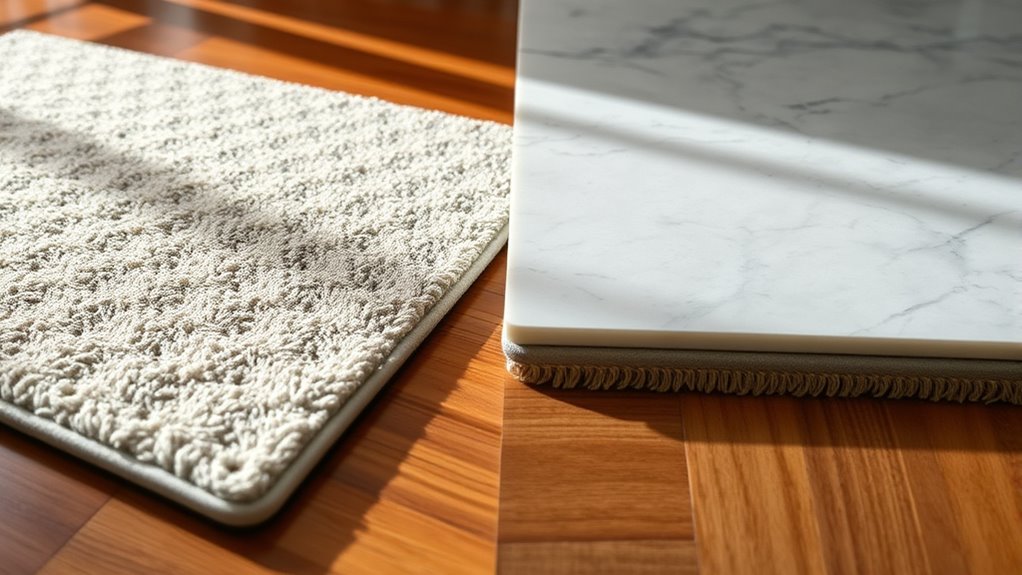
Ever wondered how your rug pad can help maintain a healthier and more comfortable home environment? Breathability and moisture control are key. A good rug pad with proper breathability factors allows air to circulate, reducing trapped humidity. Proper planning can help you select the best materials to prevent moisture buildup. Look for moisture barriers that prevent spills and dampness from seeping into your flooring. These features keep your surface dry, preventing mold and mildew growth. Imagine:
- Enhanced airflow that minimizes moisture buildup
- Moisture barriers blocking water infiltration
- Reduced risk of mold and musty odors
- Improved air quality inside your home
Additionally, leveraging air purifier maintenance can help identify potential issues with your flooring or environment before they become serious problems. Choosing a rug pad with these qualities ensures your hardwood or marble stays in top condition. Proper breathability and moisture control protect your floors and create a fresher, healthier space for you to enjoy.
Compatibility With Floor Finishes and Coatings
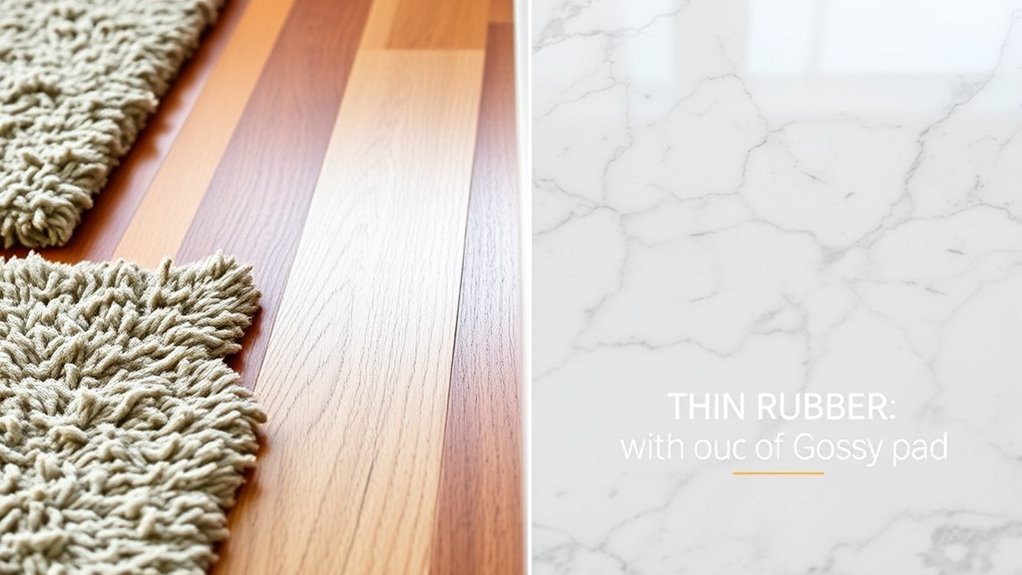
When choosing an underlay, you need to take into account how it interacts with your floor finishes and coatings. Some underlays can cause sealant adhesion issues or react negatively with certain finishes, risking damage or failure. Understanding these compatibility factors helps ensure your flooring stays durable and looks great over time. Additionally, selecting an underlay compatible with your specific surface type can prevent potential material reactions that may compromise the integrity of your flooring.
Floor Finish Compatibility
Ensuring that underlayments are compatible with floor finishes and coatings is essential for achieving a durable and attractive floor. Compatibility impacts not only the longevity of your surface but also makes routine floor cleaning easier and enhances aesthetic appeal. When choosing a rug pad, consider how it interacts with your floor’s finish:
- Prevents slipping or damage to delicate coatings
- Avoids staining or chemical reactions that could dull the finish
- Supports even distribution for consistent aesthetic enhancement
- Preserves the integrity of protective coatings during use
- Recognizing trust issues can help you select a rug pad that minimizes movement and prevents damage over time. Additionally, understanding the security measures in place at your home can provide peace of mind, especially in areas where delicate finishes require extra care. Being aware of floor finish compatibility ensures the rug pad does not interfere with the protective qualities of your flooring, maintaining its appearance and durability over the years. Proper material selection also plays a key role in ensuring that the underlay does not negatively interact with your flooring’s coatings.
Sealant Interaction Risks
Are sealants compatible with your floor’s existing finishes and coatings? Sealant interaction can affect both the longevity of your floor and rug pad adhesion. Some sealants may react adversely with certain finishes, causing discoloration or surface degradation. This can create uneven spots or weaken the bond between the rug pad and the floor. It’s essential to test a small, hidden area before applying any sealant or rug pad. If incompatible, the sealant may soften or break down, jeopardizing rug pad adhesion and risking damage to your floor’s finish. Choosing the right rug pad requires understanding these interactions to prevent future issues. Always verify that the sealant and floor finishes are compatible, ensuring a secure fit and protecting your investment.
Coating Durability Effects
Coating durability plays a significant role in maintaining your floor’s appearance and protection over time, especially when selecting compatible finishes and coatings. When choosing a rug pad, consider how it interacts with your floor’s surface resilience. An incompatible pad can cause coating deterioration, reducing surface resilience and leading to peeling or discoloration. Additionally, understanding how different materials affect self watering plant pots can help you select products that won’t damage or stain your flooring. Imagine walking on a marble surface that’s scratched or a hardwood that’s dulled. To prevent this, ensure your rug pad supports coating durability by utilizing proper materials, avoiding excessive pressure that damages coatings, using pads with cushioning that protect surface finishes, selecting materials that won’t chemically react with floor coatings, and ensuring proper thickness to distribute weight evenly. This careful approach helps preserve your floor’s protective layers, keeping it looking pristine longer.
Longevity and Maintenance of Rug Pads on Different Surfaces
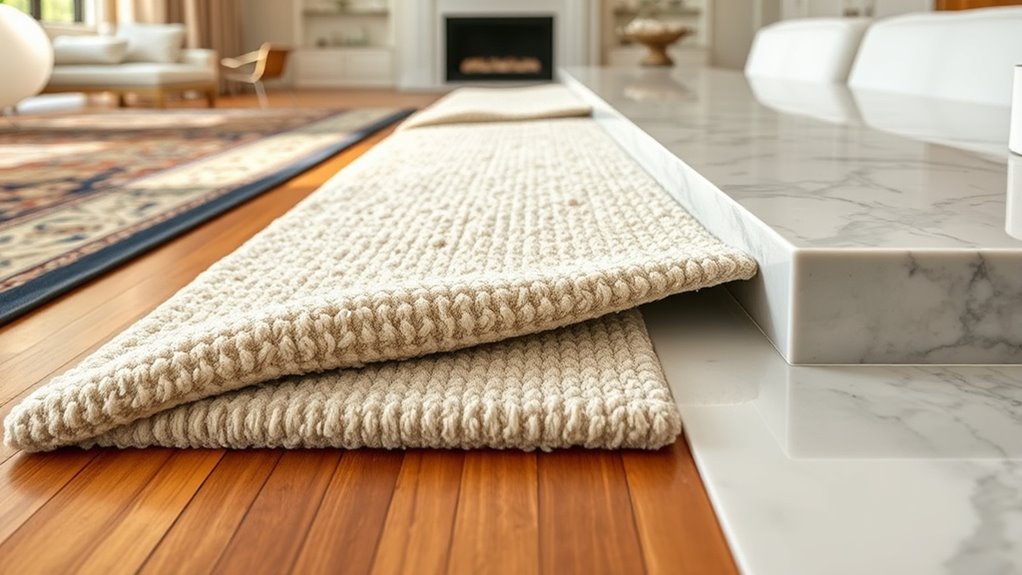
The longevity and maintenance of rug pads vary considerably depending on the surface they’re placed on. On hardwood, rug pads help preserve the floor’s aesthetic appeal and prevent slipping, but they may wear faster if exposed to high foot traffic. On marble, pads protect the surface from scratches and stains, but moisture buildup can reduce their lifespan. Regular cleaning and choosing the right material extend their usability. Here’s a comparison:
| Surface | Maintenance Needs | Expected Longevity |
|---|---|---|
| Hardwood | Gentle cleaning, avoid moisture buildup | 3-5 years with proper care |
| Marble | Keep dry, avoid abrasive cleaners | 2-4 years with regular upkeep |
| Both | Rotate rugs periodically for even wear | Varies based on use |
Cost-Effective Choices for Long-Term Floor Protection
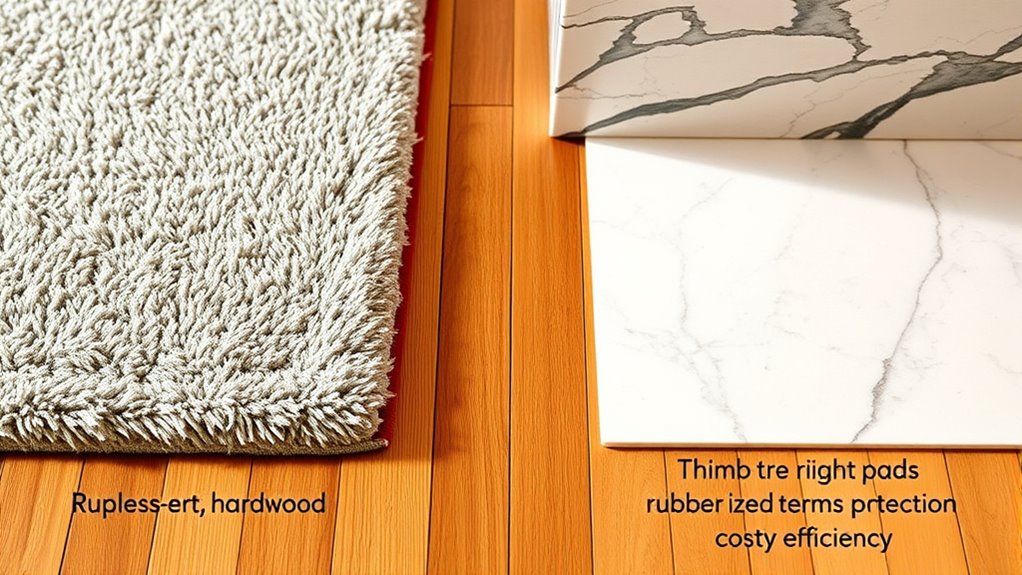
Choosing cost-effective options for long-term floor protection involves selecting rug pads and materials that balance durability with affordability. Eco-friendly materials, like natural rubber or recycled felt, offer sustainable choices that won’t break the bank. These options help preserve your floors while supporting environmental responsibility. Look for pads that provide aesthetic enhancements, such as sleek designs or transparent options that blend seamlessly with your decor. To picture the benefits:
Eco-friendly rug pads offer durable, affordable protection that enhances your decor sustainably.
- Durable, eco-friendly materials that last for years
- Affordable prices without sacrificing quality
- Enhanced aesthetics that complement your space
- Long-term protection against scratches and dents
Frequently Asked Questions
How Does Rug Pad Thickness Impact Floor Protection and Comfort?
The thickness impact of a rug pad directly influences floor protection and comfort. Thicker pads offer better cushioning, enhancing comfort underfoot and reducing impact on your floors. They also help prevent scratches and dents, especially on hardwood or marble surfaces. However, too thick a pad can cause slipping or bunching. Finding a balance ensures maximum comfort enhancement while protecting your floors effectively.
Are There Eco-Friendly Rug Pad Options Suitable for Hardwood or Marble?
Think of eco-friendly rug pads as the green thumbs of home decor. You can choose options made from sustainable materials like natural rubber, felt, or recycled felt, which are gentle on hardwood and marble floors. These eco-friendly options provide durability and comfort while reducing your environmental footprint. By opting for sustainable materials, you’re protecting your floors and supporting a healthier planet, making your space both stylish and eco-conscious.
Can Rug Pads Be Customized for Irregularly Shaped or Large Areas?
You can definitely get a custom rug pad for irregularly shaped or large areas. Many manufacturers offer custom rug pads designed specifically for your space, ensuring a perfect fit. With a custom rug pad, you’ll get better support and protection for your flooring. Just measure your area carefully, and choose a provider that specializes in creating tailored solutions. This way, you’ll have a seamless, secure fit that suits any shape or size.
What Are the Best Practices for Cleaning and Maintaining Rug Pads?
Imagine uncovering hidden dirt beneath your rug—are you cleaning and maintaining your rug pad properly? You should clean it regularly, at least once every few months, to prevent dust buildup and odors. For stain removal, act quickly with gentle solutions to avoid damage. Consistent cleaning not only prolongs your rug pad’s life but also keeps your flooring protected. Stay vigilant—your rug pad’s health depends on your care!
How Do Different Rug Pad Materials Affect Indoor Air Quality?
You should consider how rug pad materials impact indoor air quality, as some off-gas chemicals that can affect breathing and allergies. Natural materials like felt or rubber typically emit fewer volatile organic compounds (VOCs), improving air quality. Synthetic options may off-gas more, potentially lowering air quality over time. Choosing low-emission, eco-friendly rug pads helps guarantee a healthier environment in your home, especially on sensitive surfaces like hardwood and marble.
Conclusion
Choosing the right rug pad isn’t just about comfort; it’s about protecting your floors for generations to come. Whether you’re laying down a rug on hardwood or marble, pick a pad that suits your surface’s needs. Think of it as wielding a sword in a medieval joust—precision matters. With the right pad, you’ll keep your floors pristine and beautiful, standing the test of time like a true knight of home care.
